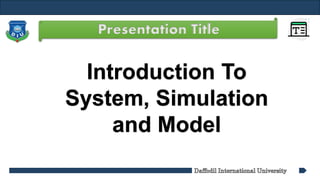The document provides an overview of systems, simulations, and modeling within various fields, emphasizing the importance of understanding components such as entities, attributes, and events. It details types of simulations including continuous, discrete, and Monte Carlo simulations, alongside the advantages and disadvantages of using simulations in analyzing and designing systems. Applications span manufacturing, logistics, construction, and military, highlighting the versatility of simulation as a tool for decision-making and process improvement.






























